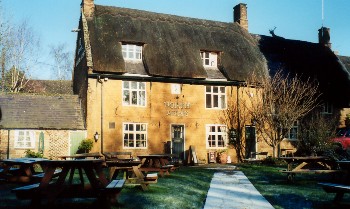|
|
The Literary Explorer
|
an ongoing series by Thomas E. Kennedy and Walter Cummins
|

|
WRITERS IN THE ABBEY:
WROXTON, OXFORDSHIRE
by Walter Cummins
What happens when you transport several dozen American writers—faculty and students of a low-residency MFA program—to a historic English mansion in a small village of immaculate thatched-roof houses, two pubs, three churches, a hotel, one mail box, but no shops? That's what we were eager to learn when in January 2003 we held our first ten-day residency at Fairleigh Dickinson's English campus, Wroxton College, housed in Wroxton Abbey, named for its twelfth-century origins as a monastery that fell into disrepair after Henry VIII's 1536 dissolution. Remnants of that structure remain in the basement beams, though the building literally rose from the ruins when rebuilt by William Pope in the early1600s and added to for several centuries after that as the property passed from the Popes to the Norths in 1677.
This relocation of writers was based on the premise that literature is more international than ever before, in the age of the Internet. In fact, student writing receives reactions from, in addition to their primary mentors, writers whose backgrounds represent a range of the globe—such as India, Vietnam, Denmark, the Philippines. Beyond the opportunity to hear readings and discussions by writers from Britain and Ireland, students would get a taste of life in another culture, which we hoped would give them a stronger context for grasping their own and somehow deepen their writing. It's much too early to tell if that will actually happen, though many on the faculty would attest to the benefits of travel for their own work.
The residency included—in addition to the visiting writers—workshops, individual conferences, faculty talks and panels, faculty and student readings, time for writing and revision, evenings in the village's two pubs—the North Arms and the White Horse, hours at email in the basement computer rooms, walks about the Abbey's 56 acres and the nearby countryside, visits by foot or taxi to the town of Banbury three miles away, and optional trips to Stratford, Oxford, or London. A number in the group had never been to the UK before, and others had only spent time in London. Some people groused about the food and the cold nights when the heat was turned off. A few caught colds and shared OTC remedies. But almost all saw it all as an adventure. Enthusiasm and energy levels ran high.
Here are some of the highlights.
The Abbey
One of the fascinations of the Abbey is its many doorways, stairways, and passages. You're constantly discovering something new—a room, an artistic treasure, a different way to get from here to there. That comes from its multiple stages of construction. Though an external view of the structure displays a balanced harmony, the inside is a jumble, just the place for writers seeking wonder rather than predictability. A few claimed to experience a ghostly presence at night—objects relocated, indentations in a pillow, a shape in a corridor. No one was alarmed.

Man in Armor
|
You could spend hours studying the dark wood carvings that dominate the Great Hall, with its fireplace and minstrel gallery, and its suits of armor, two Victorian reproductions and one authentic, with a little manikin inside, peering out the visor.
|
|
The magnificent 1623 chapel window by Abraham van Linge is a rare example of painted, rather than stained glass, the many panes first etched, then painted, and finally baked. The painted windows in other rooms were sold off when the North family, like many in the English aristocracy, ran into hard times early in the twentieth century.
|

Painted Glass
|
The various Lord Norths, the families, and their royal, literary, and Presidential visitors—James, I, Charles I, George IV, William IV, Teddy Roosevelt, Horace Walpole, Henry James, Frederick Prince of Wales (killed in 1743 when his skull was fractured by a tennis ball)—as well as the structure itself, led to the Abbey's designation as a Grade One historic site. That means the university must jump through hoops any time it wants to make a renovation or repair. For example, decaying window frames in the carriage house could not be replaced but had to be treated with a preserving chemical. Still Fairleigh Dickinson, in the forty years since it bought the property from Trinity College, Oxford, has managed to install central heating and private baths for each bedroom.
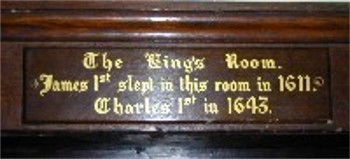
The King's Room
photo by Dale Wood
Ironically, one of the Lord Norths served as George III's Prime Minister during the American Revolution. What's left of him must be roiling in his tomb at American ownership of his estate and a horde of American writers invading his private spaces.
The Pleasure Grounds
A path circles the 56 acres of Abbey land, most of it in a treed natural state, out past the Great Pond and the Grand Castle, a small not-so-Grand Cascade, and back to the expanse of manicured lawn. All this is called the Pleasure Grounds. The site includes a Doric temple, a rose garden, a dovecote, an ice-house, a dozen shy miniature deer, many geese, and occasional foxes. Hikers explore the wooded area, and families the paths, squealing children romping on the lawns.
In the evenings after an early winter darkness, the stars shone so brilliantly that constellations stood out like ideal illustrations in an astronomy text.
Coriolanus
One of our planned excursions was a bus ride to Stratford upon Avon, just 17 miles away, for a free afternoon and an evening performance of Coriolanus at the Swan Theatre. In summer, Stratford is glutted with tourists eager to breathe the air that inspired the Bard. In January, the streets are walkable, the Birthplace relatively uncrowded, though its restored state seems like a movie set.
What struck some of our poets more than the house itself was the information about a Mrs. Hornby displayed on a bedroom wall. Living there in the late 1700s, before the Birthplace was restored as a national shrine, she conducted tours of the premises. Washington Irving, who took one, called her "a garrulous old lady with a dirty cap." Perhaps thinking she had been inspired by her surroundings, Mrs. Hornby "penned" a book of poems that a reviewer (quoted in the exhibit) said contained "the most execrable verses that human folly has yet produced.” The poets imagined a rejection slip: "Were it not for Mrs. Hornby, yours would be the most . . ."
We never did see Coriolanus. The play was supposed to start at 7:30. Shortly after 6, the town went dark from a sudden power failure. A sign tacked to the door of the Swan read “Excuse the delay. Normality shall be achieved presently.” But despite efforts to make the play go on, the performance had to be cancelled. We were told that, aside from a couple of shows stopped by a flooded Avon over the years, there had never been a power failure, at least not in our informant's 17-year memory.
The American writers assembled in the bar of the Thistle Hotel directly across from the Swan and more than amused themselves until the bus reappeared, frequently asking each other if their own normality had been achieved and answering, "Not yet." Much as the writers revere Shakespeare, they managed to compensate for their disappointment.
Visiting Writers
The poet, who shall remain unnamed, never showed. We feared an accident, a personal emergency. We had only his office number, which rang and rang. He never called to explain. Then we learned that he has a habit of ignoring scheduled appearances.
But a fortunate coincidence avoided another disappointment. Terese Svoboda, a fiction writer and poet on the MFA faculty, had just published a new collection of poems, Treason. She stepped to the lectern and gave a fine reading. The no-show British poet couldn't have been any better.
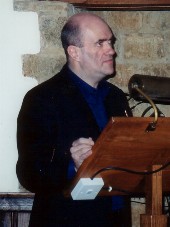
Colm Tóibín
|
Two novelists did turn up as scheduled, both world-class writers and readers. Colm Tóibín, whose most recent novel is The Blackwater Lightship, read from a work in progress based on central incidents in the life of Henry James. The section we heard imagined James' hopes for his 1895 play, Guy Domville, in its London debut and his emotions at its dismal failure. The pages evoked the inner life of a private man with strong, insightful prose. Then Tóibín answered questions, signed books, and joined a group who went to the pub, happy to chat.
|
Coincidentally, not only did James visit the Abbey, he wrote about it:
Everything that in the material line can render life noble and charming has been gathered into it with a profusion which makes the whole place a monument of past opportunity.
|
Jeanette Winterson, choosing a section from her latest novel, The Power Book, gave a vivid reading, capturing the wit of the narrator and the sharp dialogue exchanges. When asked about her ability to be so effective, she explained that her presentational ability came from her time as a tent evangelist. She delighted the poets in the audience by revealing that she turns to poets more than fiction writers for their precise sense of language, citing Alice Oswald as one of her current favorites.
|
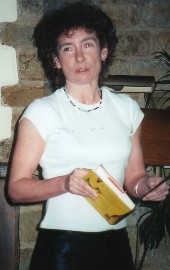
Jeannete Winterson
|
Faculty and Student Readings
Though all readings had been scheduled for the elegant Regency Room on the Abbey's second level, they were moved to the more intimate, causal Buttery, a room in the Carriage House, a separate building, with pub-like booths and stools and dozens of American college pennants pinned to the walls.
From the faculty, Terese Svoboda, turning to fiction, read a new short story; Martin Donoff excerpts from a long story in progress; René Steinke a section from Holy Skirts, her novel in progress; Laurie Stone a memoir to appear in Threepenny Review; Renée Ashley several poems (including one written as an exercise a few days before); William Zander “old” poems from his collection, Distances; David Grand selections from his recent novel, The Disappearing Body; and your correspondent a short story set in London.

Renée Ashley
|

David Grand
|
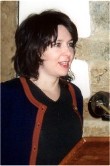
René Steinke
|

Laurie Stone
|
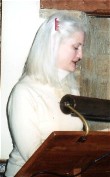
Terese Svoboda
|
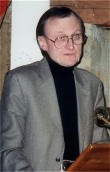
William Zander
|
The student reading took place in two segments—those new to the program first and, after a break, the returning students in an ad hoc event they called Geezerpalooza.
Pubs
|
Of the village's two pubs, the North Arms is more picturesque, attracting a range of visitors to its dining room and, in warm weather, its outdoor tables. The White Horse, one of many pubs so named in the region, feels more like a local, a pleasant place, with a large black lab dog and a lap-sitting cat. We arranged a group lunch there one afternoon—fish and chips, cottage pie, ploughmans, etc.
|

White Horse
photo by Dale Wood
|
A team took part in the North Arms trivia night, helpless when it came to English football and TV questions, and so finishing next to last. For those of us coming from the utopia of smoke-free laws, the tobacco clouds of the pubs could be a problem, clogging our lungs and saturating our clothes. But we toughed it out for the best bitter and the camaraderie.
All in All
The rooms of computers available for ongoing email checks underline how difficult it is in the 21st century to be immersed in a different place. Even if you live in an historic building, walk estate grounds, step outside the entrance pillars to an idyllic village, tour the rooms of Shakespeare's birthplace, much of your surroundings seems familiar from books, television, and films. You can find works by Colm Tóibín and Jeanette Winterson on the shelves of your local super bookstore or order them over the Internet. No place is totally new any more. Perhaps the real point of travel these days is to explore the variations of our connectedness. That in itself reveals the fuller context of our time.
[copyright 2003, Walter Cummins]
|
![]()
















